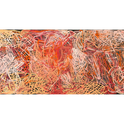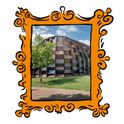I've been filming at the Basel art fair, where the contemporary art world has been celebrating the arrival of two new clients, both of whom circulated round the fair in its opening hours. There are few industries in which the addition of two customers would be considered a sign that a market was thriving, yet dealers positively clapped their hands and thanked God when Roman Abramovich and Sheikh Saud al-Thani, from the Qatari royal family, turned up at their booths in Switzerland. Suddenly the billions of losses on Wall Street, the collapse of the housing market and the second oil shock seemed like news in brief.
Admittedly, Abramovich and al-Thani are not your average client base. Abramovich has a fortune estimated at almost $12bn. He bought a Lucien Freud painting for $33m and a Francis Bacon triptych for $86m at the Sotheby's auction in New York in May—both wonderful works of art. Al-Thani has spent millions over the past few years buying Islamic art, and his resources are more or less infinite. But for the art dealers, there is something particularly significant about the profiles of these two clients—they're newbies! Abramovich's auction wins were, apparently, his first forays into contemporary art. His partner Daria Zhukova is opening a new contemporary art centre in Moscow in a stunning former train station this year. The Qataris want to build up a collection of contemporary art to house in their new museum, and last year, as the Art Newspaper recently revealed, they spent a record $10m on one of Damien Hirst's colourful pill cabinets and probably $70m on a Rothko. In other words, the Qataris and Abramovichs have only just started and are going to be spending a whole lot more. For the art world at least, "the nice decade," as the governor of the Bank of England has called it, is not yet over.
Beyond their own purchasing power, the knock-on effect of these new entrants is tremendous, thanks to the distinct properties of today's contemporary art market. For the last ten years, the rise of interest in and the rise in the value of contemporary art have been led by record-breaking auction house prices—like those for Richard Prince's "nurse" paintings, which you could buy in 2001 for $60,000 and now cost $6m, or those big Bacons which cost $10m in 2001 and now cost $80m. These huge hikes have fuelled the rise and rise of contemporary art in all kinds of ways. They have encouraged more people to start collecting art; they have encouraged banks to lend more money against art as collateral, so collectors can buy more; they have encouraged collectors to consign rare, high-quality works to the market; and they have lead to knock-on price rises across the art world, right down to east London galleries, as those squeezed out at the top turn to lesser-known, cheaper artists.
The new entrants are also vital for a second reason. At the top end of the market, there may often be only two or three players bidding on each particular artist. Each of these players is usually "heavily invested"—that is, they own several works of art by the artist in question. The artist can usually only produce enough work to supply this small group of dedicated collectors. These people thus more or less "agree" with the artist's dealer to pay increasingly high prices for work. Sooner or later, they need a new entrant, who is so keen to join the club that he will pay more than anyone has before. That confirms or increases the value of the investments of existing club members. Hence Ukrainian billionaire Victor Pinchuk kindly paid a whopping $23.6m for a shiny red Hanging Heart by Jeff Koons last November. Mystery surrounds the underbidder on this work.

Still, it's not all about money. Basel was also overflowing with great art. Our times are seeing a kind of Renaissance, with an abundance of good artists and a new accessibility in their art. Among the work on show was a large canvas from the Leipzig painter Neo Rauch, whose darkly surrealistic works have spearheaded a return to figuration. Then there was a fascinating new German artist, Anselm Reyle, who produces glitzy collages and "paintings" with high-tech materials that resemble the surfaces of moulded plastic toys. But it was Takashi Murakami's Oval Buddha (pictured above, right) that became the unofficial emblem of the fair—and a classic example of "boom art." It's a shiny, silvery, six-metre-high cartoon sculpture of a Buddha-type figure that looks like it has floated out of a Japanese animation. It's very simple, although meticulously executed and beautifully finished. But the Buddha is also just clever enough—in my opinion—to cut it as art. It's both a cartoony self-portrait and an opulent icon of today's religion of technology and gaming.











